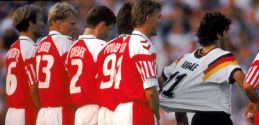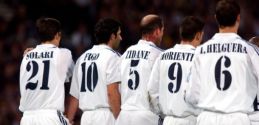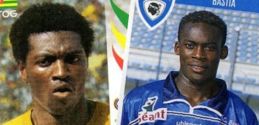 1 comments
1 comments
A guide to the 2011 Copa America: Part Five – The Contenders, Uruguay and Chile
Part five of David N’s guide to the Copa America is a beautiful beast.
URUGUAY
Santiago Silva is a fearsome, snorting, stamping bull of a centre-forward, shaven headed, tall and broad-shouldered. He can play up front alone, powerful enough to hold the ball up and bully defenders, mobile enough to work the channels. Most importantly, he has an ineffable eye for goal. He has scored everywhere he has played, from his homeland, to Brazil, for Energie Cottbus in Germany, and to a host of Argentine clubs. Recently he appears to have settled at Velez Sarsfield (though reports suggest he may be receptive to Boca Juniors’ attempts to use him as a replacement for Martin Palermo) where he is the spearhead of the attack, and where he has just won the Argentine title and scored 32 goals in 71 games.
But Silva is Uruguayan, and he can’t get a game for his country no matter how well he does in club football. Not only that: he’s really nowhere near the Uruguayan squad, with little chance of being called up barring a freak accident at a Squad Asado (barbecue) involving an exploding cow, leaving only himself and the recently-snubbed Ernesto Chevanton fit to play in attack. Because Uruguay don’t need him. Uruguay are quite rich in forwards at the moment, thank you very much.
For a country with a population of just three and a half million people, Uruguay’s achievements in international football are simply astounding. Prior to the founding of the World Cup, Uruguay won the closest equivalent, the Olympic title, in 1924 and 1928. Football had developed in a strange isolation around the River Plate in the cities of Buenos Aires and Montevideo, and the short passing style mixed with outrageous dribbles known as “la nuestra” in Argentina had a Uruguayan equivalent. This helped the two countries dominate the first World Cup tournament, held in Uruguay in 1930, with Uruguay beating Argentina 4-2 in the final. They won again, in Brazil in 1950, famously beating the hosts 2-1 in the Maracana in the decider. Since then they’ve had a couple of fourth place finishes - in 1954 and 1970 - and generally been competitive, but their status has been lowlier than such titans of the early game would expect.
The Copa America is where they tend to shine: Uruguay have won it 14 times (a record they share with Argentina), and in recent years seem to win one each decade or so. But their last win was on home soil in 1995, when a team containing two all time greats in the form of Enzo Francescoli and Daniel Fonseca, surrounded by the likes of Gus Poyet, Pablo Bengoechea and Sergio Martinez, beat world champions Brazil on penalties in the final. This is where all those strikers come in. Uruguay are due a Copa America win. And for the first time in two decades they have a squad that looks capable of that.
This is the same squad that came fourth at last summer’s World Cup, with the same coach, the massively experienced Óscar “el Maestro” Tabárez in his second spell in charge (he guided that Francescoli-Fonseca generation to the last 16 in 1990) and the same tactically precise, individually expressive approach.
Uruguay traditionally play a 4-3-3, but Tabárez is too wise to be inflexible just because of tradition, and he uses his squad cleverly to allow for maximum variation within that. The chief strength of this Uruguay is its selection of forwards, which compares well to any attacking line-up in world football at present.
The starting trio are Diego Forlan, Luis Suarez (both top) and Edinson Cavani (below). Each of those three is talented enough to play in more than one role, but the best way to use them may be with Cavani as the fulcrum at centre-forward and Forlan and Surez both buzzing around him, dropping deep and switching flanks. Cavani is the form player, having scored an outstanding 26 goals in 35 games for Napoli this season, and looking at times like the complete striker. Nicknamed “el matador” he is commanding in the air - he scored a hat-trick of headers against Juventus this season - pacy, dribbles well, strikes with awesome power from distance, has two great feet, displays clever movement, and works hard defensively. He has scored nine goals in his 25 caps but will be looking to improve that in Argentina. Suarez, who played with Cavani at Under-20 level, is a different type of player; he dribbles from deep, probes defences, plays little, outrageous flicks, drifts to the wing and cuts rapidly inside: but he is similarly prolific. With subtle, intelligent movement, he arrives in great positions repeatedly throughout games, plays one-twos, and scores with drives from outside the box. He has managed an impressive 16 goals in 39 internationals, and his understanding with Forlan is well-developed.
The most extraordinary thing about Forlan is how he has improved throughout his career. Starting as an almost old-fashioned inside forward he has developed his game to the extent that he can now play as an out-and-out striker, as a support striker, as a free-roaming playmaker (which he did to great effect on a couple of occasions during the World Cup) or even on the wing without reducing his effectiveness too sharply. He is Uruguay’s talisman, and should break records for appearances and perhaps goals scored for his country during the Copa. Currently he has 29 goals in 73 games, which seems almost poor in comparison to his club record, but his presence, work rate and leadership are as important for the side as his goalscoring.
The riches don’t stop there: the squad will also include Sebastian “El Loco” Abreu of Botafogo, only three goals behind Forlan in Uruguay’s all-time charts, who scored that nerveless deciding “Panenka” penalty against Ghana in South Africa, and whose aerial prowess is usually called upon when a goal is required in the late stages of a game. There is also the pace and skill of Seba Fernandez of Malaga and young Abel Hernandez of Palermo, both potential impact subs.
With such strength in attack, Tabárez can afford to have a relatively workaday midfield. He favours three all-rounders, based around Bologna’s Diego Perez, a tireless tackler and runner who keeps his passing simple and effective. He is usually joined by the similarly hard-working and efficient Arevalo Rios of Botafogo and either Napoli’s Walter Gargano, who is probably the most talented of this bunch, but whose form dipped late this season, or Sebastian Eguren of Sporting Gijon. In some games Tabárez asks Porto’s Alvaro Pereira to play on the left flank in a more outright offensive mode than he does for his club. He generally only risks a single creative midfielder.
Before the World Cup, young playmaker Nicolas Lodeiro made that spot his own with a dominant debut display against Costa Rica in the play-off. A high-profile move to Ajax followed, and since then, Lodeiro has endured a nightmare time with injuries, though he has been included in the Uruguay squad for recent friendlies. Another youngster, Gaston Ramirez of Bologna, an exciting and explosive young talent, may also feature. Even these players do their share of defensive work, however, and Lodeiro, a beautifully technical little player, was sent off in his World Cup debut against France for his zealous tackling.
Uruguayans pride themselves on their tremendous fighting spirit in the face of overwhelming odds; what is referred to as “garra charrúa” (Charrúan claws, in a reference to a fearsome, vanished Indigenous tribe) is frequently invoked to explain their successes in football. Over the years this has meant they have acquired a sometimes unwarranted reputation for thuggery, but also guarantees a side that works devilishly hard and plays with great spirit.
That spirit is perhaps most easily seen by observing this Uruguayan defence. Marshalled by superb captain Diego Lugano of Fenerbahce, they are tough, intelligent and experienced, and compensate nicely for each other’s weaknesses. So Sevilla’s Martin Caceres and Atletico’s Diego Godin cover Lugano’s lack of pace while his awareness and aggression keep them compact and alert. Maxi Pereira of Benfica adds some attacking dynamism on the flank, and they are tactically flexible enough to play as either a three or a four without any noticeable dip in standards. That may be as well, because the position of goalkeeper is Uruguay’s one obvious weakness, with first choice Fernando Muslera of Lazio still prone to big errors amidst his fine shotstopping and solid distribution.
All in all, Tabárez’s fine “Celeste” side must be considered possible winners of the tournament. They have the defensive solidity and firepower in attack to beat any team in the competition, and their confidence and team spirit are high after last summer’s success.
I expect them to go as far as the last four, and there face either Brazil or Argentina.
It may be relevant that the last time the Copa America was held in Argentina was in 1987, when the hosts were World Champions. And Uruguay won it…
CHILE
Alongside Venezuela, Chile are one of only two CONMEBOL Nations never to have won the Copa America. But unlike Venezuela, Chile loves football, lives football, breathes it. The Chilean Primera contains big clubs who are consistently competitive in South American competitions and produce good players: Colo Colo, Universidad de Chile, Cobreloa and Universidad Catolica among them. The national team, meanwhile, as Chileans see it, has a long history of tragedy, bad luck and bad management.
“La Roja” have played at eight World Cups, finishing third as hosts in 1962, but otherwise never escaping a group until 1998, when the team spearheaded by the awesome strike partnership known as “Za-Sa” and comprising the sublime Marcello Salas and Ivan Zamarano were eliminated by Brazil in the last 16 after terrifying a lucky Italy in their opening 2-2 draw.
That team were denied a chance to qualify for the 1990 and 1994 tournaments by the “Maracanazo”, when their goalkeeper, Roberto Rojas feigned injury after a firecracker thrown from the stands by a Brazilian fan fell near him. His teammates carried him off the pitch and refused to continue, but video footage revealed his subterfuge and Chile were banned from competing for eight years while Rojas was banned for life.
They returned for 1998, but since then have stumbled through crises and scandals. At the last Copa America, their single win and a draw were enough to see them qualify from their group, only to lose 6-1 to a strong, if second-string Brazil in the quarter-final. They have done well in the tournament before, coming second four times, in 1955 and 1956, then again in 1979 and 1987. They came third as hosts in 1991.
But the current Chilean side is easily the finest since that late-90s team, and perhaps their best ever. For that Marcelo Bielsa must take much of the credit. The Argentine coach, nicknamed “el Loco” for his fanatical obsession with detail and his authoritarian streak, took over after that disastrous last Copa and immediately altered the culture surrounding the Chilean squad. Observing the success the youth teams had enjoyed recently - most notably in the 2007 Under-20 World Cup, where they were beaten in a bad-tempered semi-final by an amazing Argentina side containing the likes of Banega, DiMaria, Aguero and Moralez - he rapidly promoted several youngsters to the first team and began drilling them in his preferred attacking style. His side played a radical 3-3-1-3, attacked ceaselessly, and qualified in second place for the 2010 World Cup. There they were a refreshing sight; a rare side who didn’t play counter-attacking football, but instead sought to attack at every opportunity. They won many new fans and even Spain’s triumph made Chile look good; in the first half of their group game, Spain looked plain bamboozled by the Chileans, and their exit to Brazil might have gone differently if the only real striker in the squad, Humberto Suazo of Monterrey, had been fit.
Since then, politics at the Chilean FA have seen Bielsa resign, and Claudio Borghi appointed. As a player, Borghi was second understudy to Maradona at the 1986 World Cup (behind the genius of Ricardo Bochini) but the most successful years of his career were spent in Chile, winning trophies with Colo Colo and Audax Italiano and ending his career with Santiago Wanderers. He began coaching at Audax, then won four consecutive titles with Colo Colo, before managing Argentinos Jrs to a title in Argentina and enduring a short and unhappy spell at Boca Juniors.
He knows and understands Chilean football in a way Bielsa never did, and if he is lacking the streak of genius possessed by his predecessor, his strength may be the ability to motivate these players, many of whom he coached at club level.
The best example is perhaps Matias Fernandez (above). Currently slightly under-performing at Sporting Lisbon, the playmaker enjoyed the best spell of his career when he emerged as a youth under Borghi at Colo Colo, where his impressive performances won him a South American Footballer of the Year award in 2006 as he drove his team to the final of the Copa Sudamerica (the South American equivalent to the Europa League). For the national team, he competes for the playmaker role with the talented Jorge “el Mago” Valdivia of Palmeiras, but he never quite showed what he is capable of under Bielsa in the 3-3-1-3 which should theoretically have suited him perfectly. The excellent documentary “Ojos Rojos” which follows the squad through the qualifiers for 2010, perhaps offers an explanation in the scene where Bielsa bellows at an injured “Mati” and mutters about him always having some injury. Borghi is probably more sensitive than the uncompromising Bielsa, and he appears particularly close to his number 14.
Borghi’s first decision was to switch to a 3-5-2 and allow his team to sit back instead of constantly pressuring, then to spring forward on the counter. Fernandez has thrived in this new system, allowed more space and responsibility, and he has scored with beautiful free kicks in recent friendlies against Portugal and Colombia.
The fluidity in attack characteristic of Bielsa’s system is still present under Borghi and this young side have clearly benefitted from their recent success. But Bielsa was somewhat fortunate to uncover a core group of such talent. The defence - usually led by Cruz Azul’s well-travelled Waldo Ponce - is relatively the weakest area of the team, and both Borghi and Bielsa played so as to protect it.
Gary Medel, Sevilla’s short, combative central midfielder, is key here. For Bielsa he usually played as a defender, but Borghi uses him alongside the underrated Carlos Carmona of Atalanta as a pair screening the defence, with Fernandez just ahead. Arturo Vidal, seemingly bound for Bayern Munich this summer after an exceptional spell at Leverkusen, is talented and versatile enough to play in any position in midfield or defence, and he is usually played as a holder or in a wing back position. The starting wing-backs are usually Udinese’s Mauricio Isla on the right and either Mark Gonzalez of CSKA Moscow or Birmingham City’s Jean Beausejour on the left, all aggressive, pacy options.
The player most UK fans will want to see is one of Borghi’s two strikers. Alexis Sanchez of Udinese, (above) wanted by seemingly every major club in Europe, played on the right of the front three for Bielsa, and is a winger by trade. But this season his coach at club level, Francesco Guidolin, moved him into the support striker role and watched him transform both his own and his teams form. A thrilling dribbler, with pace, strength and invention, he is brilliant one-on-one and scores stunning goals, and is now a constant menace from central positions. He has scored 12 goals in 36 games for his country, an amount bettered in the Copa America squad only by Humberto Suazo, with 18 goals from 45 caps. Suazo is strong, direct, good in the air and capable of creating his own chances. As his absence from key games in 2010 showed, he is also crucial to Chile’s chances of success.
And be sure; they do have a chance. Under Bielsa, Chile played with a devil-may-care expectation that though they would concede, they would always outscore the opposition, and although Borghi appears to have tightened the team up defensively, that still seems to be the case to a certain extent. But this is a young, hungry team full of talent and hard work, capable of blowing teams away when they build up a head of steam, and they will be favourites, alongside Uruguay, to qualify from their group.
After that, nobody will relish a tie with Chile, and if they hit form, they could go all the way in this tournament.
More of David N’s musings on football from South America and beyond can be found on GolGolGolGolGol and also on his Twitter page.
Tags: , , , , , ,Share this article
Leave a comment
- When did co-commentary become such a serious and miserable business?
- Why do we devote so much time to sharing our love of football for free?
- Villa’s Tokyo downfall: The apparent formality of a world title match
- Son Heung-min and the forgotten wonder goals
- Guess the Premier League goalscorer from the GIF
- A fateful flight
- Goodbye to the instant analogue gratification of Ceefax
- Player Profile: Steve Ogrizovic
- Rejecting FA Cup money in favour of a car boot sale
- It’s a man’s world? Former Arsenal manager crosses the gender divide












The videos are really great and thanks for that. The entire post you write is just blowing my mind..keep it up..dude…
<a href=“http://www.timberlandcase.com/”>Display case for football</a>